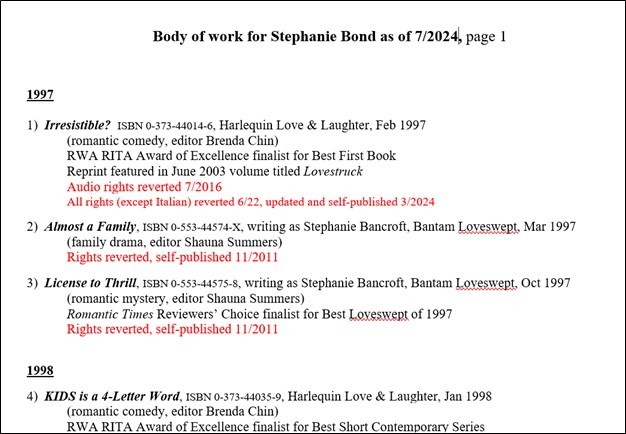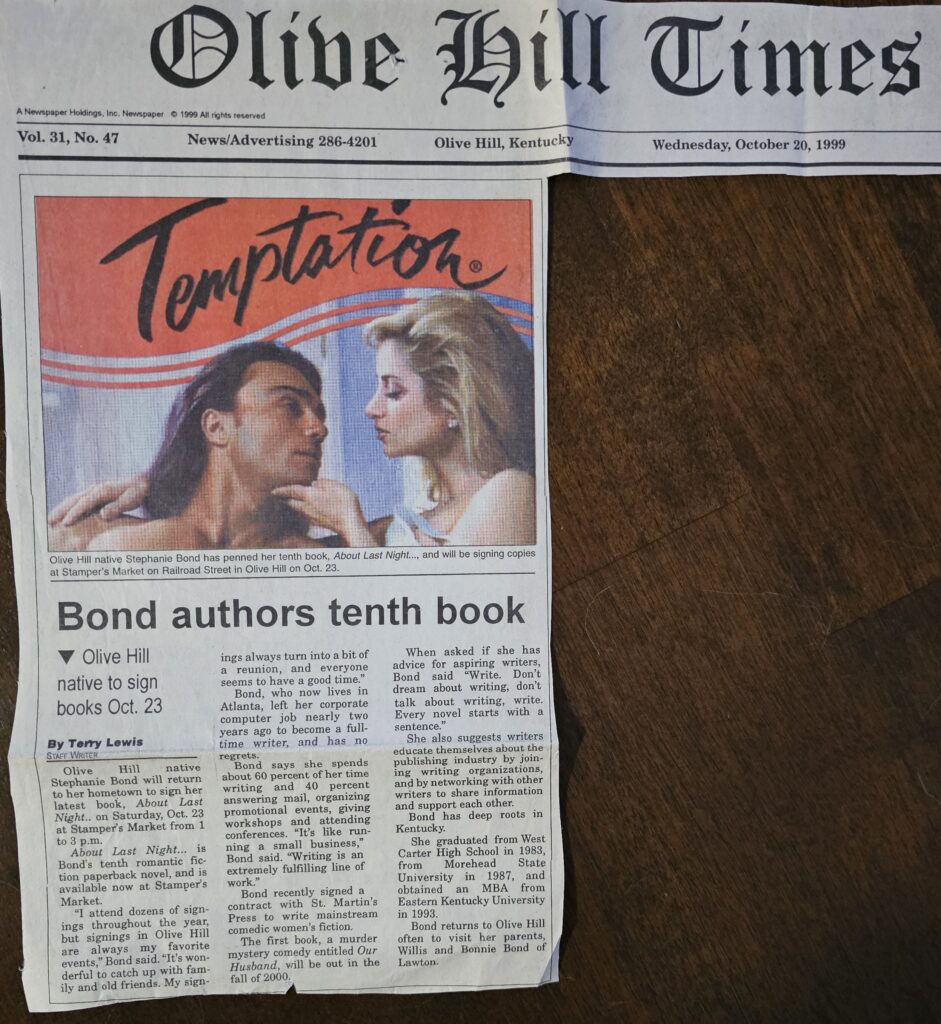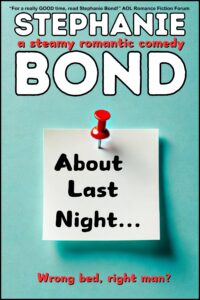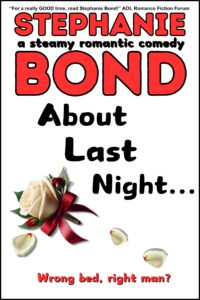← (Return to Chapter 9: Steamier Romances... and a New Challenge)
A sister writer emailed a few weeks ago to say she was reading this STORIES BEHIND THE STORIES memoir and asked how on earth I remember all these things? I had to laugh because there are SO many things I’ve forgotten, which is why at times I’ll probably be going back to update these chapters.
One document I’m leaning on heavily to inform these chapters is a list I’ve maintained in a word processing file from the beginning of my career that I’ve titled Body of Work. In this file I list all my published works chronologically, along with the editor’s name, the publisher, the original ISBN (International Standard Book Number), the genre, and pertinent information like subsidiary rights sold, any special reviews or awards the book received, and any reprints.
I remember sharing with my critique partners when I first created the document after my first couple of books were released. I felt a little silly because at the time it seemed incomprehensible that I could forget a single detail about any of my published books. But I was also aware how quickly things were moving—it was common to be working on three books at one time that were in different stages of completion, and I was always thinking ahead to future projects I could pitch. When I received author copies of my newly released books, they would seem distant in my mind because I’d written two or three other projects by then. Two romance lines I’d written for had already announced they were closing. I’d barely gotten my writing career off the ground, and I was starting to feel like a veteran in the industry. And because I planned to write many books in my career, I had a suspicion that documenting my releases would be beneficial in the future.
Spoiler alert: The document grew from one page to now more than twenty-one pages, and I can’t count the times I referred back to it to answer questions for my editors, agents, reporters, but mostly for myself! In fact, as I write this, my Body of Work document is open in another window for me to refer to.

A snippet from page 1 of my Body of Work document
Another good use of the Body of Work document is for my heirs to refer to in order to trace the history of each of my titles as they were published, as some rights were reverted to me, and the books were republished under my own self-published imprint. Because as attentive as my family members have been over the years, let’s face it—after a while, the titles and covers begin to blur. Toss in occasional title changes and different versions of covers and even I can get confused! So if you’re a creative entrepreneur, I encourage you to document your products. Not only is it a smart thing to do for your business portfolio, but reviewing your body of work is a great mood-booster if you find yourself in a creative lull.
Back to my writing career. When I left off, I was waiting to hear if my humorous romantic mystery Our Husband, about three women who learn they’re married to the same man, would find any takers among New York publishers. I was a nervous wreck because it would mean a big leap in my career from writing category romance to writing single title books. After a long period of feedback during which I massaged my idea until it was unrecognizable, then back again, my agent called to let me know that… wait for it… more than one editor was interested!
In fact, two editors were willing to make offers.
My agent and I discussed the offers. You might think that an author automatically takes the offer with the highest advance, and it’s true that the advance money is all an author can really count on.
Sidebar: A book advance is just that—an advance on future earnings. Generally a publisher will offer an advance that reflects what they believe an author will earn in royalties in a certain amount of time, and every publisher has their own timeline. I should note here, though, that if an author doesn’t earn back their advance, they don’t have to pay back the difference. Also, if an author doesn’t earn back their advance (referred to as a book “earning out”), the publisher can still earn a boatload of profit on that book. I’m venting here because I’ve heard too many times that authors were let go from a publisher because their book didn’t earn out. When an author’s book doesn’t earn out, all it means is the publisher shared more of the profits with the author than they intended! And while it’s true that not every book earns the publisher a profit, profits are more prevalent today because selling ebooks has very little overhead, and print books are typically printed in small quantities on-demand. I’m not saying that publishers are making more overall than they did ten or twenty years ago… I contend it's easier for each title to turn a (small) profit today than it was back when a large print run and high returns could crater a book’s profit margin. Also, when I say an ebook has “very little overhead,” I mean for that individual title. The primary overhead for a publisher is in its experienced staff—editorial, sales, marketing, distribution, etc., but those overhead costs are spread over all books the publisher releases.
But back to my offer. Yes, a higher advance is attractive, no doubt. And my belief has always been the more a publisher invests in an advance, the more they’re forced to up their sales and marketing game to recover their investment. But there are other elements of an offer to consider—where the book will be placed in the publisher’s lineup, the planned format(s) of the book (hardcover, oversized paperback, mass market paperback, ebook), the print run, the anticipated cover price, the release date(s), the proposed marketing plan, creative control (will the author have cover approval?), what rights are being purchased (foreign language? Audio?), and other factors such as is this a one-book offer, or is the publisher willing to invest in the author’s future by offering a 2- or 3-book contract? And more esoteric elements such as whether the editor making the offer has a track record of growing their authors’ careers.
All that said, I had a difficult decision to make—one editor, Stephanie Kip at Bantam, was someone I’d worked with before and liked very much. Plus I was grateful to Stephanie for giving feedback that got the project back on track. The other editor was Jennifer Enderlin at St. Martin’s Press, whom I knew only by good reputation. My agent and I discussed the offers carefully and in the end, we both decided the package being offered by St. Martin’s was more attractive in terms of launching my single title career. My agent made the call to accept the offer, and I was walking on air!
But meanwhile, I had projects in the pipeline at Harlequin—and I wanted to continue writing for them. And while it might seem as if me selling to a competitor would create conflict, it was in Harlequin’s long-term best interests if another publisher put out my books in a bigger way to a larger audience so those readers would cross over to read my Harlequin books. Because the book I’d sold to St. Martin’s Press wasn’t a “category romance” that would compete with my category romances with Harlequin, I was free to use my name, Stephanie Bond.
The pen name of Stephanie Bancroft I’d used for Bantam Loveswept was officially retired.
And suddenly I was busier than I thought possible. I was writing projects for Harlequin at the same time I was writing Our Husband, a book that was more than twice as long as my Harlequin manuscripts. And because there were fewer slots for single title books to be released each month, it would be a while before Our Husband would be published. In fact, I would release five more Harlequin titles before Our Husband hit the stands.
Next up for Harlequin was a book called About Last Night. My editor had asked me to come up with an idea that would fit in the Harlequin Temptation mini-series “The Wrong Bed.” Every story in the mini-series would feature a story in which—you guessed it—someone in the story ends up in the wrong bed.
A word here about constraints. Creative constraints are when you’re handed some part of the concept and asked to put your own spin on it. Previously I mentioned my sophomore English teacher read the beginning of a story and asked the class to write their own ending. That’s a constraint. I actually prefer constraints because it gives me something to springboard from. Because there were already several “The Wrong Bed” books published, I skimmed them to get the gist of the premise so I wouldn’t inadvertently repeat something that had already been done. Here’s what I came up with:
A bride-to-be who’s worried because her groom hasn’t wanted to consummate their relationship decides to slip into his room at the hotel where he’s having a bachelor party and, ahem, force the issue. Except she winds up crawling in bed with the Best Man! And before they can right the situation, the hotel is placed under quarantine because a mysterious contagious illness breaks out and they’re forced to stay in the room together.
(This was 1998—twenty-two years before Covid-19 would change how the world perceived contagion in public places and forced proximity.)
My editor loved it, so I set about writing the first few chapters. I felt that the heroine Janine needed a confidante, someone who would encourage her to do something that was out of character for her but with her best interests in mind. So I gave her a sassy sister. The sister was great—she gave my heroine the nudge she needed to pull off the stunt. And as the hotel fell under quarantine, her sister was the person on the phone who helped her get through it.
Then my editor called. The publisher was still receiving letters from readers who wanted more of my character Manny Oliver, who had to this point appeared in my first book, Irresistible?, in Wife is a 4-Letter Word, and Naughty or Nice? Could I please include Manny is this book, too?
Well, the first two books Manny appeared in were in Atlanta; in the third book he moved to San Francisco to work in a hotel. This book was set in Atlanta and in a hotel, so theoretically I could have him move back and stay in the hospitality industry. I agreed to add Manny to the plot and I backtracked to weave him into the story.
But suddenly Janine was confiding in her sister AND in Manny. I realized entire conversations were repeated as Janine shared with each of them what was happening in the hotel room where she and the Best Man (Derek) were confined. So I scaled the sister waaaaay back and give the role of confidante to Manny. It was a good writing lesson for me to learn and I knew I was getting better because I realized what was wrong before my editor had to point it out.
By this time, I’d also happened upon a workflow that would change the way I wrote for my Harlequin editor Brenda Chin. The way we worked was typical—I would sell a story with a long synopsis that described the characters and how the story began, progressed, and ended. Once Brenda approved the story I would write the entire manuscript and send it in by the deadline. She would read it as her schedule allowed and create a revision letter with “big picture” things to change as well as specific changes on pages throughout the manuscript. She would return the marked up and flagged manuscript with the revision letter and I would make the changes, print a revised manuscript and send it back to her. With the first few books, there were at least two rounds of changes, which took a loooooooong time, and the logistics of mailing the full manuscripts back and forth was clunky.
I also noticed that if there were “big picture” problems, they generally occurred in the first few chapters of the manuscript, which would snowball into more and more changes as the story unfolded in a direction that wasn’t what Brenda had in mind. So I suggested that I write the first several chapters and send them to her to review, then she would read and send me back revisions on those pages. I would make changes she wanted, then keep going. Then I would send her another chunk of chapters with a “Here’s what happened up til now” summary to remind her of the plot details. Then she would read the second chunk and send me revision notes on THOSE chapters, and so on. That meant that usually when I typed “The End” the story was in pretty good shape because I’d made changes all along. It sped up the editing process dramatically because it was easier for her to make time in her day to read a few chapters rather than an entire manuscript. This “edit-as-we-go” workflow was instrumental in me being able to write multiple manuscripts for Harlequin in a year’s time.
I was happy with the story I’d written for About Last Night, and that I’d figured out a way to plot a connected book (the hero’s brother) to write later. But when the cover proof arrived, I confess I wasn’t thrilled. Neither character looked like the characters in my book, although I conceded it had a sexy vibe. Note the icon denoting the book as belonging in “The Wrong Bed” mini-series. And it sold just fine—Romantic Times Book Reviews (click on the link to read more about this wonderful magazine that uplifted the romance genre) gave it a good review, saying it had “an unusual plotline.” Unusual plotline—hold that thought!

Original cover for About Last Night... These people are pretty but they look nothing like my characters!
And in between writing, writing, writing, I was still setting up booksignings when and where I could. Here’s a piece from my hometown paper, Olive Hill Times, announcing a signing at the local grocery that carried my books at their meat counter! 😊 In the article I gave the following advice for aspiring writers that I still stand by:
“Write. Don’t dream about writing, write. Every novel starts with a sentence.”
So true!

Announcement of a booksigning at my hometown grocery store... the full original cover of About Last Night was a little too racy for the front page of the Olive Hill Times. :- )
Harlequin recently reverted the rights to About Last Night back to me, so I’m in the process of updating the book. Ugh, what was “an unusual plotline” when it was released in 1999 is not so unusual (or sexy) in 2024, post-Covid, so I have my work cut out for me!
Plus I need a new cover—and your help! I’ve designed a couple I like, but I’d really love your feedback to get it just right before I put up a pre-order for the updated version of About Last Night. Here are the covers I came up with:


Will you email me at stephanie@stephaniebond.com to let me know which one you like? I’ll also post this on my Facebook page and ask for comments there. (Note--the voting has ended! See the next chapter for the resulting cover!)
Next up in STORIES BEHIND THE STORIES: My decision about the cover for About Last Night based on your feedback! Also, how I wrote Harlequin’s first ever interactive story for their website! ~